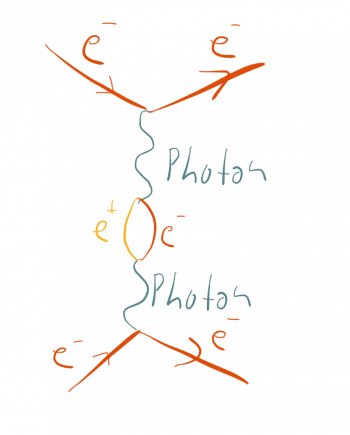Add a new page:
This is an old revision of the document!
also known as Quantum Fluctuations
 A quantum vacuum fluctuation is a process where from the vacuum a pair of particle and antiparticle emerge and subsequently vanish again.
A quantum vacuum fluctuation is a process where from the vacuum a pair of particle and antiparticle emerge and subsequently vanish again.
The particle and antiparticle pop into existence and then vanish again. The particles that appear in such a process are known as virtual particles.
A quantum vacuum fluctuation does not violate the conservation of any charge since a particle and antiparticle are created at the same time which carry exactly the opposite charges.
The energy that is necessary to create the particle-antiparticle pair is "borrowed" from the vacuum which is in agreement with the "energy-time" uncertainty principle as long as the pair vanishes fast enough again. Similarly, the necessary momentum is borrowed from the vacuum which is allowed thanks to the "momentum-location" uncertainty principle.
 Since such processes are allowed in quantum mechanics the vacuum is never really empty. Instead, it is a boiling sea of particles-antiparticle pairs that pop into existence and then vanish again.
Since such processes are allowed in quantum mechanics the vacuum is never really empty. Instead, it is a boiling sea of particles-antiparticle pairs that pop into existence and then vanish again.
These vacuum fluctuation can be observed, for example, in the form of the famous Casimir effect. Here an attractive force between two plates is measured which is a result of the vacuum fluctuations.
Another instance where virtual particles appear is in particle interactions. When two particles, like two electrons collide it can happen that the photon, which is responsible for the interaction, is converted into a electron-positron pair and then back into the photon. These virtual particles must be taken into account in calculations to get the correct results.
Recommended Resources
Virtual particles appear in quantum field theory as higher order corrections to scattering amplitudes. At tree level two particles scatter, for example, by simply exchanging a photon. The first order correction in perturbation theory can be interpreted as an additional process where the photon becomes virtual electron-positron pair and then again back a photon.
The total cross section is the sum over all such possible processes. At higher orders more and more virtual particles can appear. However, processes with many virtual particles are increasingly unlikely and therefore it is a valid approximation to only consider the first few order in perturbation theory.
Recommended Resources
Talk about quantum fluctuations can be vague. There are really 3 different types of fluctuations: Boltzmann, Vacuum, & Measurement.
There are no real one-particle systems in nature, not even few-particle systems. The existence of virtual pairs and of pair fluctuations shows that the days of fixed particle numbers are over." Viki Weisskopf